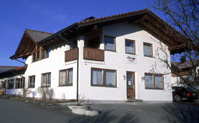|
HRB Munich 52509, general manager: Dipl. Ing. Thomas Finsterwalder
The Finsterwalder GmbH consists of 2 companies with different main focuses:
|
| • |
The administrative center in Munich with main focus on hangglider-service, hangglider-, components-, fitting-, helmet-development und -production, shop and webshop with complete assortment.
|
| • |
The branch Charly-Products in Seeg with main focus on paraglider-wholesale, harness- and rescue systems-development, -production und -wholesale including service, webshop with main focus on sportswear and paragliding accessories.
|
|
 |
|
» Contact & routing
The history of Finsterwalder & Charly
|
 |
|
|
|
|
 |
1963-1982
At the age of 16 Thomas Finsterwalder became self-employed and produced white-water boats and kayaks from fibreglass/diolen with two hired hands.
The design was revolutionary and trend-setting: The white-water boats had an elliptical layout for the first time, and a kidney-shaped cross-section.
The kayaks had a trapeze-shaped rear that later helped racing kayaks to Olympic victories.
Grammar school and engeneers degree were successfully completed alongside the boat production.
|
|
 |
|
1972
Thomas Finsterwalder purchases an "Alpine Glider" from Hartmund Huber (known locally as the "Huber Stone" since it had a glide angle of 1:stone).
5 minutes of instruction from Hartmut Huber on the telephone was sufficient: Ski launches and touch-downs from the Stubai glacier worked out fine from the beginning.
The 20 kg Alpine Glider could be rigged down to a length of 2 m and taken on mountain hikes. However, spanners and screwdrivers were necessary for the assembly.
Wonderful flights were made from the Alpspitz summit in Garmisch and from Pitz Palü.
1973-1974
Thomas Finsterwalder developes a glider of his own design.
With specially developed high-strength super light-weight and large diameter perunal tubing, the "Bergfex" (mountain freak) weighed a mere 11 kg and could be dismanteled in 8 minutes down to a length of 1,80 m without the use of tools, by means of snap fasteners.
Mountaineering pilots became more and more - soon, no peak was save from them anymore.
|
 |
|
|
 |
|
|
 |
|
 |
|
 |
|
1975
Adventure in Peru..
|
 |
|
1976
Over the new year of 1976, Thomas Finsterwalder, Albert Leutenmaier and Heinz Walter achieved the first successful flight from the 5950 m high summit of Kilimandscharo.
1977-1979
With tents and hanggliders on the 5776 m high summit of Christobal Colon in Columbia. It was planned to fly from there to Santa Maria on the coast, some 48 km away.
After 3 days bivouac on the summit this expedition had to be abandoned due to storms, snow-blindness and altitude sickness. The 100 km return descent had to be made without provisions.
Successful flight followed from the summits of the 5465 m high Popokatepetl (Mexiko) and the 5671 m high Demavend (Iran).
|
|
|
 |
|
|
 |
|
1977 - The Bergfex
The picture shows the elastic deformation of the Bergfex under a load of 700 kg. The sail weighed only 1 kg and was made from spinnacker nylon 32 g/m².
The federal aviation authority issued the airworthiness certification. More than 300 Bergfexes flew accident-free.
1978 - The Superfex
680 units of this manoeuvrable and high performance, 15 kg light-weight mountaineering glider were built.
The Superfex was one of the first gliders to achieve the DHV certification.
1979 - The Jetfex
1981 - The Windfex
The revolutionary new construction with integrated cross-tube and pre-shaped mylar leading edges was sold to over 900 pilots.
The 19,5 kg light-weight glider was also certified for trike use.
1982 - The Minifex
Characterised by extreme manoeuvrability, this glider could be packed down to 1,65 m and had fibre glass wing-tips.
1883 - The Skyfex
Construction of a sickle-shaped high performance glider with 100% double-surface sail. However, neither performance or handling were convincing. Flight characteristics were unconvincing even even with rudders and this project did not get beyond six different prototypes.
Also the development of a duck-wing with 1 m wing depth and 12 m span whose wings could be pushed together like an accordian did not get to the stage of serial production.
1985 - The Topfex
With the Topfex, a forgiving, high-performance glider was achieved. Shortly after serial production began, a large fire that broke out in a neighbouring car factory completely destroyed all Finsterwalder stocks and machinery (see photo).
|
 |
|
|
 |
 |
 |
Production could first be resumed in the spring of 1986 in a newly constructed workshop in Munich-Allach. Our current glider program perfex, funfex, lightfex, airfex, speedfex, as well as glider components, carabiners and buckles have been manufactured there ever since.
|
|
 |
|


|
 |
1990
With the takeover of the company Charly Products (at that time leading manufacturer of rescue reserves and harnesses), Finsterwalder & Charly manage to access the paragliding market.
As German distributor for EDEL, the company managed to sell over 1000 paragliders annually.
1994
Charly and NOVA become partners.
|
 |
 |
|
 |
|
Die Charly-team in Seeg
|
 |
|
|
 |
|
|
 |
|
Successful Finsterwalder & Charly Best of Air-innovations, patents, registred design, ornamental design:
Hanggliders:
|
 |
|
|
 |
|
|
 |
|
Rescue reserves:
|
 |
|
|
 |
|
|
 |
|
Harnesses:
|
 |
|
|
 |
|
|
 |
|
Accessories:
|
 |
|
|
 |
|
|
 |
|
Hardware for paraglider harnesses:
|
 |
|
|
 |
|
|
